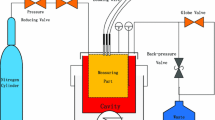Abstract
The correlation between the diffusion permeability of thermoplastic polyurethanes by kerosene and kerosene volatility is studied. The kinetic dependences of kerosene mass loss in a diffusion cell differ from the conventional dependences that confine the application of commonly accepted parameters in estimating the diffusion permeability of polymers and the natural loss prediction model. An approach to estimating the rate of natural kerosene loss under storage is proposed. The correlation between the natural loss rate at different kerosene storage temperatures and the kerosene vapor pressure at room temperature is established to simplify the method of estimating the diffusion permeability of thermoplastic polyurethane by kerosene.




Similar content being viewed by others
REFERENCES
K. Karadeniz, Y. Zalıkoğlu, and M. Y. Sen, “A novel polyurethane from epoxidized soybean oil synthesized by ring opening with bifunctional compounds,” Polym. Bull. 74, 2819–2839 (2017).
M. A. Levina, D. G. Miloslavskii, M. V. Zabalov, and M. L. Pridatchenko, “Green chemistry of polyurethanes: synthesis, functional composition, and reactivity of cyclocarbonate-containing sunflower oil triglycerides-renewable raw materials for new urethanes,” Polym. Sci., Ser. B. 61, 540–549 (2019).
Yu. N. Rybakov and N. A. Vanchugov, “Application of elastic tanks at aviation fuel supply complex facilities,” Nauch. Vestn. Mosk. Gos. Tekh. Univ. Grazhd. Aviats., No. 183, 173–175 (2012).
Yu. N. Rybakov, “Contribution to the theory and practice of chemotology in the field of creating field fuel storage facilities,” Khim. Tekhnol. Topliv Masel, No. 5, 23–26 (2014).
ATL Drop Drum™ airs lift able fuel trac sport bladders. http://www.atlinc.com/pillow.html.
A. V. Ivanov and Yu. N. Rybakov, “Storage and transportation of fuel using elastic tanks in the US army,” Zarubezh. Voen. Obozr., No. 8, 54–57 (2015).
A. V. Ivanov, US Army Fuel Supply System (Voenizdat, Moscow, 2018) [in Russian].
Yu. N. Rybakov, A. V. Dedov, N. S. Rushkin, and D. S. Plokhoi, “Reducing the permeability of elastic tanks for storing oil and petroleum products,” Vse Mater. Entsiklopedicheskii Spravochnik, No. 5, 13–16 (2018).
Yu. N. Rybakov, S. N. Volgin, S. V. Larionov, and A. V. Dedov, “Forecasting the kinetics of fuel losses during storage in polymer tanks,” Nauka Tekhnol. Truboprovod. Transporta Nefti Nefteproduktov 8, 143–145 (2018).
I. D. Asmetkov, D. V. Kolotilin, and A. V. Dedov, “Permeability of thermoplastic polyurethane for fuel storage tanks,” Plast. Massy, Nos. 5–6, 48–50 (2018).
A. V. Dedov, and S. V. Larionov, “Permeability of polymer materials for technical means of storing petroleum products,” Nauka Tekhnol. Truboprovod. Transporta Nefti Nefteproduktov 9, 440–443 (2019).
D. V. Kolotilin, A. V. Dedov, and Yu. N. Rybakov, “Tightness of polymer tanks for transportation of fuel by air,” Vse Mater. Entsiklopedicheskii Spravochnik, No. 12. P. 34–37 (2019).
A. V. Dedov, D. V. Kolotilin, and R. I. Kunnap, “Methodology for assessing the tightness of polymer tanks for transporting fuel by air,” Plast. Massy, Nos. 1–2, 46–48 (2021).
P. V. Moskalev and V. V. Shitov, Mathematical Modeling of Porous Structures (Nauka/Interperiodika, Moscow, 2007) [in Russian].
V. N. Manin and A. N. Gromov, Physicochemical Resistance of Polymer Materials Under Operating Conditions (Khimiya, Moscow, 1980) [in Russian].
A. E. Chalykh, Diffusion in Polymer Systems (Khimiya, Moscow, 1987) [in Russian].
K. Kim, J. Heo, and N. Sung, “Study on thermophysical property characteristics of a 4 species kerosene surrogate in a swirl injector at supercritical pressure condition,” J. Korean Soc. Propulsion Eng. 17, 48–58 (2013).
K. I. Gryadunov and T. M. Maslova, Chemmotology and Quality Control of Fuels and Lubricants. Aviation Fuels: Educational Method. Manual. (Mir, Moscow, 2019) [in Russian].
S. G. Alekseev, A. S. Avdeev, and N. M. Barbin, “Methods for assessing the explosion and fire hazard of fuel-air mixtures using the example of RT grade kerosene,” Pozharovzryvoopasnost 21, 33–37 (2012).
Funding
This work was supported by ongoing institutional funding. No additional grants to carry out or direct this particular research were obtained.
Author information
Authors and Affiliations
Corresponding author
Ethics declarations
The authors of this work declare that they have no conflicts of interest.
Additional information
Translated by E. Glushachenkova
Publisher’s Note.
Pleiades Publishing remains neutral with regard to jurisdictional claims in published maps and institutional affiliations.
Rights and permissions
About this article
Cite this article
Kolotilin, D.V., Manzhelii, E.A., Shchepilov, D.O. et al. Estimating the Fuel Permeability of Thermoplastic Polyurethane from the Saturated Vapor Pressure of Kerosene. Polym. Sci. Ser. D 16, 1004–1007 (2023). https://doi.org/10.1134/S1995421223040159
Received:
Revised:
Accepted:
Published:
Issue Date:
DOI: https://doi.org/10.1134/S1995421223040159




